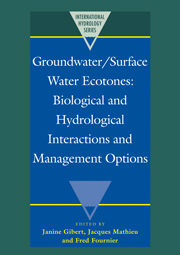Book contents
- Frontmatter
- Contents
- List of authors
- Preface
- I INTRODUCTION
- II FUNCTION OF GROUNDWATER / SURFACE WATER INTERFACES
- III MALFUNCTION OF GROUNDWATER / SURFACE WATER INTERFACES: CAUSES AND METHODS OF EVALUATION
- IV MANAGEMENT AND RESTORATION OF GROUNDWATER / SURFACE WATER INTERFACES
- V CONCLUSION
- ANNEX
- Round Table 1: Riparian vegetation and water quality improvement
- Round Table 2: Biodiversity in groundwater/surface water ecotones: central questions
- Round Table 3: Modelling of flows at the interface
- Round Table 4: Contribution of the groundwater/surface water ecotone concept to our knowledge of river ecosystem functioning
Round Table 3: Modelling of flows at the interface
Published online by Cambridge University Press: 07 September 2010
- Frontmatter
- Contents
- List of authors
- Preface
- I INTRODUCTION
- II FUNCTION OF GROUNDWATER / SURFACE WATER INTERFACES
- III MALFUNCTION OF GROUNDWATER / SURFACE WATER INTERFACES: CAUSES AND METHODS OF EVALUATION
- IV MANAGEMENT AND RESTORATION OF GROUNDWATER / SURFACE WATER INTERFACES
- V CONCLUSION
- ANNEX
- Round Table 1: Riparian vegetation and water quality improvement
- Round Table 2: Biodiversity in groundwater/surface water ecotones: central questions
- Round Table 3: Modelling of flows at the interface
- Round Table 4: Contribution of the groundwater/surface water ecotone concept to our knowledge of river ecosystem functioning
Summary
Modelling the flows across the groundwater/surface water ecotone often concentrates around the following questions: (1) why should we model, (2) what kind of fluxes and scales should be considered in our models, (3) possibilities and difficulties when using models developed for other purposes, (4) communication gaps and future research needs.
(1) The modelling of ecotone-related fluxes may (and should) be used in the following cases:
– to test assumptions and hypotheses
– to improve our understanding and insight into the processes
– to design new experiments and to optimize sampling strategies
– to generalize and synthesize the results
– to develop scenarios and make predictions.
The development of scenarios is felt as one of most important tasks. The ecotones are subjected to the increasing pressure of various human activities (river flow regulation, groundwater extraction, irrigation, non-point pollution etc.), and we need more efficient tools to predict possible impacts of these activities and to improve the management practices. The situation is particularly critical in the third world where hundreds of millions of people live on the surface/groundwater ecotones, depending on them and affecting their function.
(2) The groundwater/surface water ecotones convey numerous fluxes – of water, heat, solutes, particulate matter, genetical information etc. (Gibert et al, 1990). All these fluxes occur on different spatial and temporal scales (Franzle & Kluge, in prep.).
Information
- Type
- Chapter
- Information
- Groundwater/Surface Water EcotonesBiological and Hydrological Interactions and Management Options, pp. 236 - 237Publisher: Cambridge University PressPrint publication year: 1997
